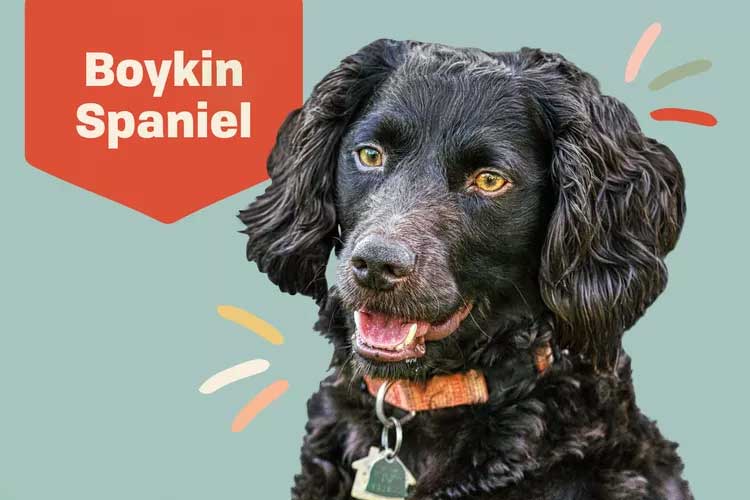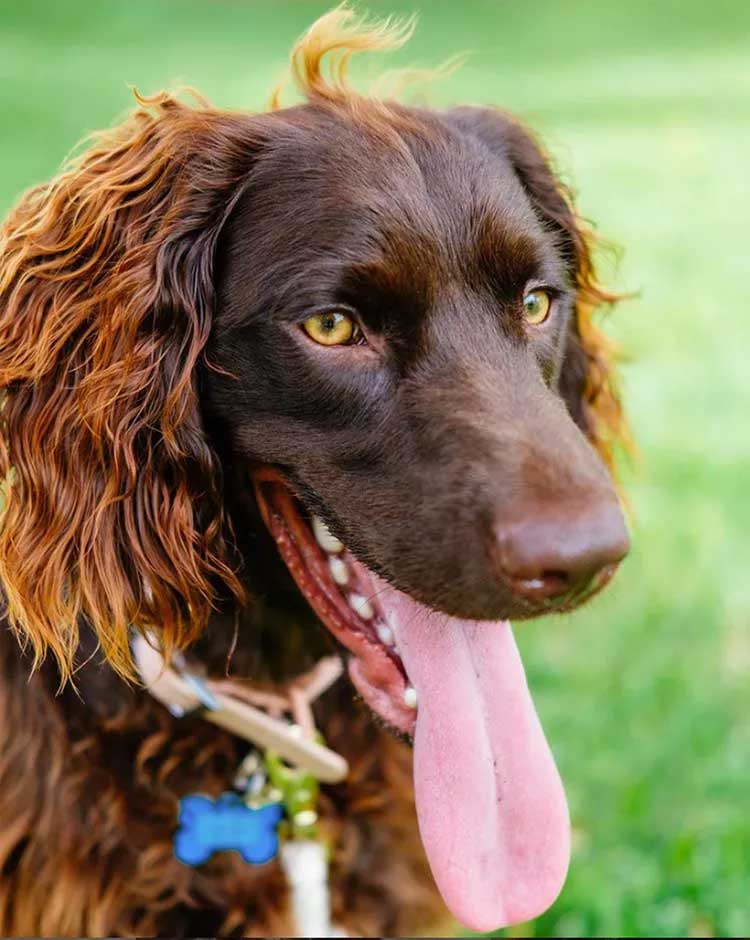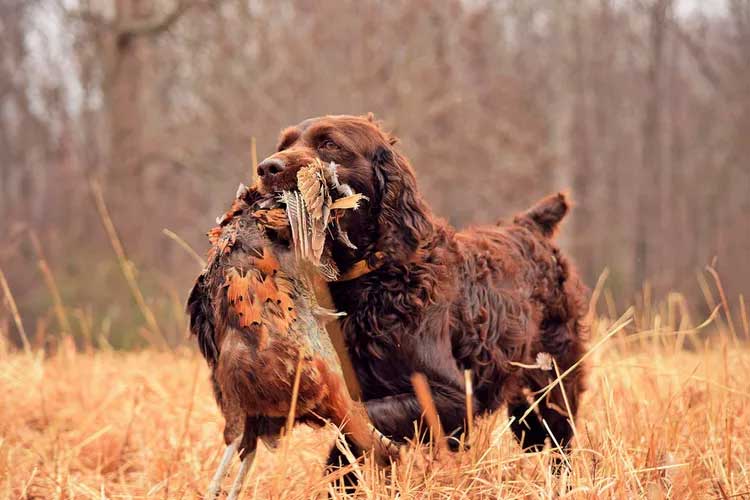One of a small number of AKC-recognized breeds to be wholly developed within the 20th century, the Boykin spaniel is a brilliant, energetic, all-American dog with an eye toward hunting and water retrieval.

Boykin Spaniel Overview
| OFFICIAL NAME | Boykin Spaniel |
| COMMON NAME | Boykin Spaniel |
| PET HEIGHT | 14 to 18 inches |
| PET WEIGHT | 25 to 40 pounds |
| LIFESPAN | 14 to 16 years |
| GOOD WITH | children, dogs, families |
| TEMPERAMENT | friendly, outgoing, playful |
| INTELLIGENCE | high |
| SHEDDING AMOUNT | seasonal |
| EXERCISE NEEDS | high |
| ENERGY LEVEL | active |
| VOCAL LEVEL | when necessary |
| DROOL AMOUNT | low |
| BREED GROUP | sporting |
| BREED SIZE | medium (26-60 lbs.) |
| COAT LENGTH | medium |
| COLORS | brown / chocolate / liver |
| PATTERNS | bicolor |
| OTHER TRAITS | cold weather tolerant, easy to train, good for first-time pet owners, good hiking companion, hot weather tolerant, loves water, requires lots of grooming, strong loyalty tendencies |
One of the few breeds to be developed completely within the United States and entirely after the turn of the 20th century, the Boykin spaniel is a new kid on the dog block A South Carolina native, the Boykin spaniel was developed as a hunter custom-built for the swampy American southeast.
Delightfully spirited companions, these spaniels are super intelligent, eager to please, and energetic. Their highly adaptable nature makes them great pets in almost any environment—as long as they get enough exercise. Outstanding as hunters and as family members, they're adept at obedience, agility, and retrieval competition work as well.
Appearance
Adult Boykin spaniels stand 14–18 inches tall and usually tip the scales between 30–40 pounds, placing them between the English cocker and English springer spaniels in terms of size. Boykins are solid-colored, appearing in chocolate, liver, and brown shades, occasionally with a splash of white on their chests. Their eyes are similarly dark-colored, most usually in brown or amber tones.
Boykins' coats are of medium length, and the dogs carry thick undercoats to help keep them warm and dry in cold, damp areas. Their coats may feature some feathering on the chest, legs, belly, and ears, and some Boykins have a top knot, similar to the Llewellin setter. Additionally, they have special webbed feet that make them excellent water retrievers.
At birth, Boykins come with tails that are roughly the same length as their bodies, but for hunting dogs, these are usually docked shortly after birth. This practice is controversial, and proponents say it's to prevent the longer tails from getting caught or injured on underbrush or trees in the field. But, according to the American Veterinary Medical Association, docking is usually done for cosmetic reasons and has no proven health benefits.
Temperament
Boykin spaniels' temperaments are similar to those of most of their spaniel cousins: They are extremely intelligent, eager to please, and full of energy. They share the adaptability of English cocker spaniels and can do well in most any living environment, provided their exercise needs are met. If you're not a hunter, exercise can be as simple as a long walk every day or some time playing fetch in the backyard. Boykins have incredible stamina and make great hiking, biking, and jogging companions as well.That energy and athleticism also mean Boykins are enthusiastic participants in agility, hunting, and obedience competitions. They also love anything that allows them to splash around in water. According to the Boykin Spaniel Society, one of the traits the Boykins were developed for was the ability to hunt from a boat. As a result, these "swamp poodles" are great passengers in canoes and kayaks, with a well-earned reputation for staying calm on moving decks and not, well, rocking the boat.

"Boykin spaniels are very people-oriented; they're very friendly," says Timothy Bartley of R & D Boykin Spaniels. "They want to be around people. They don't want to be left alone; even if you take your dog out to the backyard, if you don't stay with the dog they're going to be wondering where you're at."
Because of Boykins' extremely loyal, human-centric personalities, those who are left by themselves often can become stressed and lonely, experiencing separation anxiety that most commonly manifests itself through chewing, digging, and stress barking.
Like the majority of spaniels, Boykins will always let you know when a delivery person or neighbor is approaching. Once a newcomer is inside the house, Boykins are welcoming hosts and will greet their guests with tail wags and doggy kisses.
If you are a hunter, it's difficult to find a better companion than this little brown dog. Boykins were originally bred to be turkey and waterfowl retrievers, hunting the swamps of South Carolina from flat-bottomed boats or canoes. They hold their cool around gunfire and learn and respond to hand and whistle signals well. Their extremely high stamina and tolerance for warm weather have also made them excellent companions in dove fields, and their speed and eagerness for the hunt has even made them effective at driving larger game like deer.
Living Needs
Can you throw a ball? Does at least one of the doors in your house go outside? Congratulations! You've got everything you need to make a Boykin spaniel happy. Boykins develop deep bonds with their people and will happily go where their humans go and live where they live, just so long as they can get outside and work off some of that energy every day.
"You can have a Boykin on a ranch, you can have a Boykin on a farm, you can have a Boykin in a home, you can have a Boykin in an apartment," Bartley says. "It doesn't matter as long as every day you're able to take them out and give them what a Boykin spaniel needs. They need to be able to run and chase and retrieve things."
Boykins are easy enough to keep happy that they're a good fit for novice pet owners. But it's important to note that Boykins will require an hour or two outside every day, and they get bored easily when not supervised. For this reason, couch potatoes may want to look elsewhere, as Boykins are definitely suited to active households.
That said, Bartley says Boykins aren't "a constant hyper dog" and are typically very mellow house pups who are happy to lounge on the couch and watch a movie with their owners (again, as long as they got to exercise earlier in the day!).
They do very well in households with children, although any youngsters should also be supervised and taught how to responsibly play with their dogs. Boykins live well with other dogs and, when introduced patiently, living with cats shouldn't be a problem either. If you are getting a Boykin spaniel puppy, begin socializing her within the first few months so she isn't afraid of larger dogs and understands cats are friends.
Care
The Boykin's coat features a thick undercoat, so seasonal shedding will be a factor no matter what you do. Give your spaniel's coat a good brushing at least once a week to keep it free of debris and mats and to remove any loose hairs. If you're a hunter or hiker, giving the coat a quick pre-brush before any activity will help keep her fur from clinging on to burrs and sticks. And any time your Boykin has been splashing around in saltwater or ponds with algae, give her a freshwater spray-down soon after.
Paired with regular brushing, Boykins can stand to be trimmed every couple of months or so, depending on how long you keep her hair. Giving her a bath every 90 days or so should be plenty to keep any Boykin fresh and shiny. And, like all dogs, she'll need her nails trimmed, teeth brushed, and ears cleaned.
Health
Boykins are relatively healthy dogs with very low instances of many of the ailments that are common to other dogs. There are, however, some health concerns to be aware of.According to the bred club, Boykins are susceptible to:
Hip dysplasia: A genetic condition where the dog's hip joint doesn't develop properly. This can lead to pain and osteoarthritis.
Patellar luxation: This is when a dog's kneecap dislocates. Typically, the joint will pop back into place, but surgery might be recommended in severe cases.
Juvenile cataracts: This can lead to blindness.
Collie eye anomaly: A genetic disease where the eye doesn't develop properly, resulting in blindness.
Degenerative myelopathy (DM): A disease impacting the spinal cord, causing increasing weakness and ultimately paralysis and death.
Pulmonic stenosis: A congenital heart defect that can lead to heart failure.
Exercise-Induced Collapse (EIC): A genetic trait found primarily in Labradors and other breeds of retrievers, as well as the Boykin spaniel.
Keep in mind: This list doesn't mean your Boykin spaniel will develop these conditions. Rather, these are health issues to test and stay vigilant for. Because the breed is so new, that number of ailments has been dropping in recent years as the Boykin Spaniel Foundation has worked with breeders and veterinarians on selectively breeding these traits, such as hip dysplasia, out of the dogs.
"We've created all of these dog breeds through selective breeding," says Dennis Riordan, DVM, of the Riordan Pet Hospital in Des Moines, Iowa. "The only way you can ensure specific traits is to selectively breed dogs. Until those breeds are 'perfected,' for lack of a better word, you're going to concentrate those (bad) genes as well."
As for EIC, "They get overheated or overworked, and they just drop," Riordan explains. "It's not a seizure, but they just can't move their legs for about 15 minutes. Some dogs grow out of it, some dogs have it from birth, but it doesn't appear to affect life span or overall health. It's just something that owners have to be aware of."
Before bringing home a Boykin spaniel puppy, your breeder should conduct all health tests recommended by the Boykin Spaniel Foundation. If you're adopting, ask the rescue for all available health information on your Boykin.
History
The Boykin spaniel has the distinction of being one the few breeds created wholly within the 20th century and entirely in America. They are also one of the most recently registered breeds; the American Kennel Club gave Boykins full recognition in 2009.
The first precursor to the breed was a small, stray spaniel-type dog who took a liking to a Spartanburg, S.C., banker named Alexander White as he was walking near his church one day in the early 1900s. According to Charleston Magazine, White kept the little dog, whom he named Dumpy, and noticed he had an aptitude for retrieving. So he sent Dumpy for further training to his friend and hunting partner Lemuel Whittaker Boykin in the neighboring town of Camden. Boykin spent time training Dumpy and testing his natural hunting abilities, turning him into a very effective turkey and waterfowl retriever. Eventually, Dumpy became the foundation upon which the Boykin spaniel breed was built.
Boykin reported using Chesapeake Bay retrievers, springer spaniels, cocker spaniels, and American water spaniels in future breedings. For decades, the Boykin spaniel was almost exclusively found in the swampy wetlands in South Carolina, until hunters visiting from other parts of the country began to take notice of the area's spunky little water dog.
Fun Facts
Boykin spaniels are one of just two American-born breeds (along with the Plott hound) to be named after the family responsible for their creation.Not just an American creation, the Boykin spaniel is a uniquely South Carolinian dog. So much so that it is the State Dog of South Carolina, and September 1st is Boykin Spaniel Day in the state.